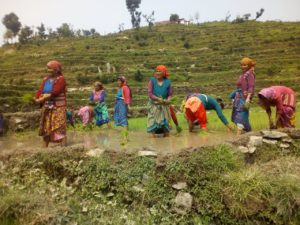By Dr Vandana Shiva – Jivad, Vandana Shiva’s blog, 2 July 2019 | Source
India is a land of Diversity – of climates, plants, food and agriculture systems, languages and dress.
We have every climate of the world – the desert in Rajasthan, the semiarid tracts of the Deccan, the rich coastal ecosystems, the rainforests of the Western Ghats, and the temperate zone and the Third Pole in the Himalaya.
Each region has evolved agriculture systems, crops and food adapted to the diversity of nature and diverse local cultures that co-evolved with nature.
In Rajasthan and the Deccan we had the millets, pulses, oilseeds. Orissa and Chattisgarh are the Vavilov centres of rice where indigenous communities evolved more than 200,000 varieties of rice. The Western Ghats gave us the spices. And the Himalaya gave us amaranth, buckwheat and a diversity of other nutritious crops.
 Today India is facing a Water Emergency and a Nutrition Emergency. The two emergencies are interconnected. Agriculture systems that rob us of nutrition also rob us of water. Agriculture systems that disrupt the nutrient cycle contribute to malnutrition, climate change and desertification. The nutrient cycle which replenishes soil organic matter is the basis of maintaining the water cycle. Both cycles get broken by the same ecological processes. The seeds for today’s emergency were sowed 40-50 years ago with World Bank advice and the Green Revolution.
Today India is facing a Water Emergency and a Nutrition Emergency. The two emergencies are interconnected. Agriculture systems that rob us of nutrition also rob us of water. Agriculture systems that disrupt the nutrient cycle contribute to malnutrition, climate change and desertification. The nutrient cycle which replenishes soil organic matter is the basis of maintaining the water cycle. Both cycles get broken by the same ecological processes. The seeds for today’s emergency were sowed 40-50 years ago with World Bank advice and the Green Revolution.
The Green Revolution has destroyed our water, our soil, our biodiversity. Green revolution varieties of rice and wheat were forced on Punjab, destroying the fertile land with chemical monocultures, and creating neglect for the regions rich in biodiversity of rice – like Orissa and Chattisgarh. https://www.amazon.in/Violence-Green-Revolution-Agriculture-Politics/dp/0813166543
There are three ways in which the dwarf varieties of rice and wheat contribute to the water emergency.
Firstly, Green Revolution varieties are thirsty varieties, requiring ten times more water to produce the same amount of food.
Secondly, Green Revolution varieties are bred as dwarf varieties to take up more chemicals, and avoid the problem of lodging when chemicals are applied to indigenous varieties. As dwarf varieties are grown as monocultures, Green Revolution varieties violate the law of return on which sustainability is based. They give no organic matter back to the soil, diminishing the capacity of soil to hold water. While just1% organic matter in soil can hold up to160,000 litres per ha.
Thirdly, Chemical fertilisers used in chemical farming kill the soil organisms that create living soil. The soil begins to become desertified, needing more frequently irrigations, leading to a deeper water crisis.
The solution to the water crisis begins by growing water-prudent tall indigenous varieties of seeds which produce more biomass in their straw, which we can then return to the soil, allowing us to follow nature’s law of return. Indigenous farming systems based on indigenous seeds are water conservation systems because they maintain and renew both the nutrient cycle and water cycle.
Instead of recognising that growing water intensive monoculture rice in Punjab has broken nature’s two vital ecological cycles and of recognising that crops should be planted in ecosystems to which they are ecologically adapted, and instead of promoting biodiversity of indigenous seeds of crops where they have evolved and of giving up chemical farming and shifting to organic, there is now an attempt to criminalise rice itself and destroy our biodiversity and culture. We call rice Akshat (which means whole, not broken) and Prana (breath considered as the life giving force and universal energy which gives us life ). This assault on rice is an assault on our civilisation and ecological heritage.
Like rice, sugarcane – called IkSuka in Sanskrit – evolved in India in the Gangetic plain where there is abundant water.
The World Bank imposed sugarcane cultivation in the semi arid Deccan region of Maharashtra in place of the millet jowar. The Deccan region is in the rain shadow of the Western Ghats and has an average rainfall of 600mm. Because of the Deccan Trap, only 10% of the rainfall goes to recharge the ground water annually. Jowar uses only 250mm and also gives back large quantities of organic matter to the soil, increasing soil moisture. Sugarcane requires 2500 mm, and has led to water mining and the dry wells we see on TV, a direct result of the ill advised World Bank Policy of growing sugarcane in a water scarce area. https://www.amazon.in/Water-Wars-Privatization-Pollution-Profit/dp/089608650X
High cost drip irrigation which costs Rs 45000 to Rs 75000 per ha will increase the financial stress on the farmers, and not repair the broken water cycle. We need to bring back the jowar millet to address the water emergency in Maharashtra.
The Green Revolution was neither Green, not Revolutionary. It was a project for colonising India’s food and agriculture. It has left us with a severe water crisis. With the ecological and social emergency we face, we need a real food and water revolution based on indigenous seeds of water prudent nutrition crops like desi wheat, desi rice, desi dal, desi tilhan, and millets, the forgotten foods. An agriculture based on regenerating soil fertility and soil moisture through organic farming can address both the nutrition and water emergency. It also addresses Climate Change.
This is our Jaivik Kranti. Our Revolution for Life.
